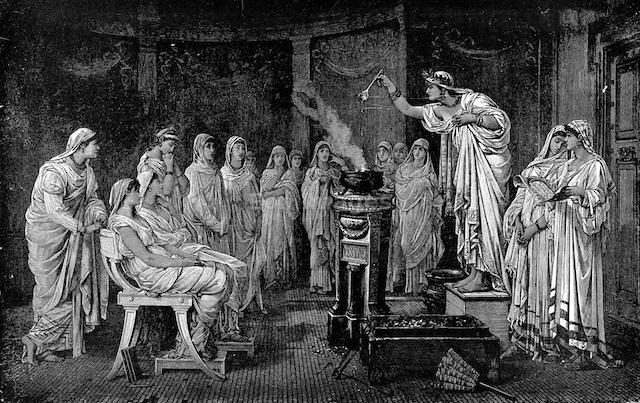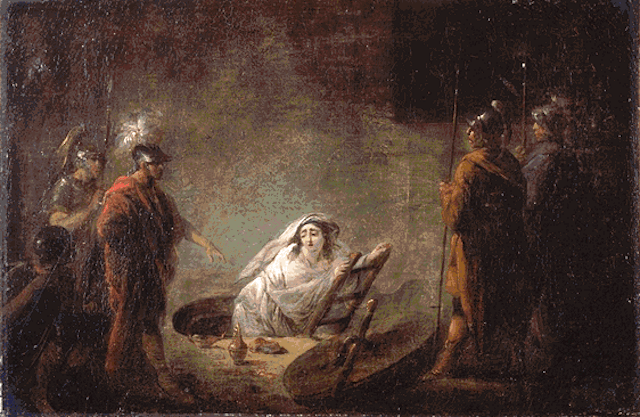Aside from possibly Greece’s Oracle of Delphi, the Vestal Virgins devoted to the Roman goddess Vesta, ruler of the Hearth, are the most famous ancient cult in European history. Yet most people don’t really know much about this esteemed group, even though they were one of the most enduring organizations in Roman history.
Its name, and the associations the average reader has with the word “cult,” will likely give an impression that the organization was more sinister or more fanatical than the historical record indicates. Not that there weren’t some unsavory aspects to the religion, but you’ll get that with any major belief system, particularly in ancient times. So let’s get to know these women in white a little better.
10. Virginity was Not Just a Religious Requirement, It was a Legal Technicality

As BBC explains, the reason that it was so important the Vestal Virgins never had sex with anyone wasn’t just a religious matter related to sex (or the lack thereof) having a mystical value. It was largely because of what those women represented in an official capacity. See, priestesses at the Temple of Vesta didn’t merely serve the faith of one particular goddess.
They were supposed to be, in a very real sense, married to the entire city of Rome. So if the Vestal Virgins had sex, it wouldn’t mean that they were betraying the tenets of their religion. It would mean they were guilty of a much more Earthly crime: Treason. And unless the person they had sex with happened to not be from Rome, it was also regarded as incest. We’ll talk more about the consequences of this later.
9. There Were Few of Them at Any Given Time

Given how long their legacy endured, and that the city of Rome was large enough to have a permanent population of over a million people for centuries, you’d think there was a significant holy order of Vestal Virgins. But in fact the holy order was not at any one time large enough to staff a modern day McDonald’s restaurant for a single shift. There would only be six of them in the order at any given time, and these were women with a rather large number of diverse duties to perform.
These duties included preparing ritual food, maintaining a holy spring, keeping the eternal flame of their goddess Vesta burning, officiating holy services that could stretch out for weeks at a time, filing and maintaining wills and testaments for citizens, and so forth. Surely there would be a strong desire for at least a few of them to stray, and you’d imagine a few more redundant virgins would be kept around. Even the famous pop song “Whiter Shade of Pale” mentions “sixteen Vestal Virgins.” Further, that was a significant expansion since, when the Temple of Vesta was first founded, for awhile there were only four of them.
8. Family Connections Were Severed

Unlike any other cult in Roman society, when a girl was selected for the Vestal Virgins, she had to cut off all ties to her family for the 30 year span that was expected of her before she was allowed to leave the order, as Robin Wildfang explains in his book Rome’s Vestal Virgins. The rationale for this was that they were supposed to be connected to the entire city while performing their duties, and having a family was too much connection for anyone that needed to be completely objective for the city’s sake.
This seemingly horrible situation did at least mean that when the Vestal Virgins left the order, they could at least own and make determinations over what happened to their property. That was, provided they didn’t decide to marry after their time in the Vestal Virgins was up, which may have been a significant contributing factor to the fact most of them chose to live out their days single (additionally there was a belief among the Vestal Virgins that any marriage for them would be unlucky even though their respected positions meant plenty of men wanted to marry them, as said in Gary Westfahl’s A Day in Working Life).
7. Their Blood Must Never be Shed

Like the situation with Genghis Khan when he executed his brother and other respected authority figures, there was a requirement that the blood of a Vestal Virgin was not supposed to be shed, even in the event they broke their vows. Also like the Mongols, the Vestal order found a way around that. One of the more notable methods of executing a tarnished member of the order, described by Ancient.eu, was to pour molten lead down their throat. A less violent but no less cruel method was to bury them alive outside the temple gate. A little place called Collina, where the historian Plutarch noted wryly that a “little mound of Earth stands,” is a reminder that there were indeed enough Virgins that were put to death this way to effect the shape of the soil.
Surprisingly, they were given small amounts of food and water prior to burial, which feels as if it were done just to prolong the agony a little. There was at least some sense of fairness in that their sex partner was put to death with them. There was nothing that dictated that the blood of someone joining a Vestal Virgin in death was not to be shed, so they were usually whipped to death.
6. Decade Long Stations

Despite the fact that those who inducted into the Vestal Virgins were supposed to be without physical defects and the best of elite families, apparently little faith was placed in their abilities to learn the duties of their priesthood, as reported by the Numismatic Circular. For the first ten years of their time at the temple, they were effectively apprentices which, since the average inductee was around ten years of age, means it pretty much took up all of their adolescent years, though some particularly bright girls joined the order when they were only six years old. Then for ten years they actually put their education into practice running the temple. For the final ten years of their term they each took one of the new Vestal Virgins under their wing and taught them.
Susan G. Bell, in her book Women, states that any Vestal Virgins that didn’t want to risk married life or other pursuits outside of the religion decided to stick around, since there was no obligation for them to leave. One, named Occacia, decided to stay in the service for fifty-seven years and another named Junia Torqutta did more than double duty and stayed a Vestal Virgin for sixty-four years.
5. Hair Offerings

It was felt the duties of Vestal Virgins required cutting them off from general society in a number of ways. They were kept in carriages while they moved through Rome’s busy streets. In court, they technically weren’t under oath when they gave testimony. When they went to the Colosseum, they were given special seating in private boxes. But probably the single most prominent thing they did that went against mainstream Roman practice took place during March ceremonies, as explained by Sarolta Takács in Women in Religion.
Since March 1 was a sacred public holiday, particularly to the goddess Juno (who was the highest of all goddesses in Roman religion), a tribute needed to be offered. The Vestal Virgins were required to go to Esquiline Hill. There were two lotus trees located there, and lotus trees had mythical importance in Rome because legend said the nymph Lotis was supposed to have been turned into one of them as a way of being saved from a sexual assault. During the ceremony, the Vestal Virgins were to take their hair and leave it on the trees. Since hair had a secondary meaning, indicating that someone was supposed to be a child bearer, placing their hair on a symbol of prevented rape was a layered gesture of their commitment to chastity.
4. Holy Beatings

Not every priestess who was disciplined was put to death, though the punishments for even the most minor of infractions were very severe. Those who were judged as not being sufficiently pure in thought, or not dutiful enough with their holy obligations, were to be beaten. But not by just anyone, since the consecrated flesh of a Vestal Virgin was not to be touched; not even by a Vestal Virgin. Thus, the same Pontifex that was the only person the Vestal Virgins were to answer to was the only one who could punish them.
Such was the nature of the Vestal Virgins that even official beatings had an element of discretion about them. While the sinner was to be naked when they were beaten, the room was supposed to be too dark for them to be seen. As if that wasn’t enough, the Pontifex and the Virgin were separated by a curtain during the process, as told by Women’s Life in Greece and Rome. Considering that it was part of the doctrine that the blood of a Vestal Virgin was never to be shed, it does raise the issue of how the Pontifex was supposed to make sure that they beat the person they couldn’t see in such a way that they didn’t draw blood.
3. Military Scapegoats

Of all the duties that the were bestowed on the Vestal Virgins, by far the most significant to the Romans on the street was the keeping of the fire of Vesta burning in a round temple called the Forum Romanum. This act of appeasing the Gods was necessary for Rome’s military to be successful, as it conquered new territories for slaves and other resources and defended against the barbarians. For the military and elite class, they were much more useful for saving face.
When Rome’s troops suffered a disastrous defeat, instead of needing to blame their commanders, the Vestal Virgins were perfect for blaming instead. A loss simply must have meant that they had been impure in some way, either by committing some sort of incest or by not maintaining the fire properly. So it’s possible that in Rome no one was more desperate for Roman military success than the Vestal Virgins, who might have been completely true to their vows and buried alive anyway.
2. Unsavory Origin

The earliest days after Rome’s founding after Romulus and Remus don’t get a lot of attention, but the Vestal Virgins gained their esteemed position very quickly. Indeed, they even predated the Republic, which is practically synonymous with Rome in people’s minds. After the death of the very warlike Romulus, the second king was Numa Pompilius, a monarch as pious as they came. In the seventh century BC, he founded the College of the Vestals and installed the first priestess as part of an attempt to lessen Rome’s militarism by making the rest of the city more pious.
But rather than volunteering for the honor, the first Virgin inducted was actually abducted from her parents by the Pontifex Maximus. Martin Goodman, in The Roman World, tells us the ancient Roman historians Plutarch and Aulus Gellius rather vividly described her abduction “as though she had been captured in war.” Her name was Amata, and ever after whenever a girl was recruited into the Vestal Virgins it was customary for the Pontifex to refer to her as Amata in her dubious honor.
1. Officially Banned

When the Roman Empire adopted Christianity as its state religion in the fourth century AD, it inevitably meant that the days of the Vestal Virgins were numbered. The Temple of Vesta was closed in 391 AD, which was a particularly bad sign. It was made official when Emperor Theodosius I banned every religion in Rome except Christianity in 394, and even the religion that had been the most esteemed in Rome for seven hundred years wasn’t spared.
The last senior member was Cordelia Concordia, whom Women’s Life in Greece and Rome credits with being one of a handful of Vestal Virgins to be commemorated with a statue. They at least had some vindication in that Rome was sacked by barbarians multiple times less than twenty years after they were abolished. Furthermore, in 2008, the traditions of the Vestal Virgins were reported by CCTV International as making a comeback.
Dustin Koski has never been a Vestal Virgin, but he writes horror fiction for the internet, which is close enough.
1 Comment
Interesting – I thought, before reading this, Vestal Virgins were everything but virginal. Hmmm..